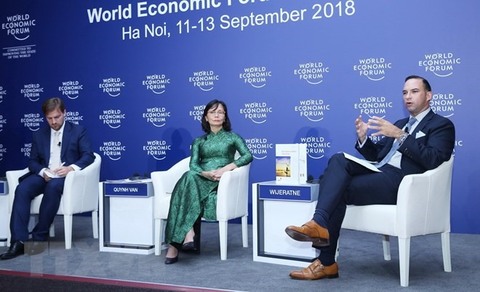
According to David Wijeratne, PwC leader of growth markets centre, ASEAN is depending too much on trade with outside partners.–VNA/VNS Photo Lam Khanh
The Association of the Southeast Asia Nations (ASEAN) will have to improve internal trade to reduce dependence on outside partners and boost the region’s economic growth, according to PricewaterhouseCoopers (PwC) senior officials.
According to David Wijeratne, PwC leader of growth markets centre, ASEAN is depending too much on trade with outside partners.
In the context of declining global trade, the Chinese economic slowdown and the potential US-China trade war, that dependence would make ASEAN economies vulnerable, Wijeratne told a press conference during the World Economic Forum ASEAN 2018 on Wednesday.
Another challenge for ASEAN economies is the Fourth Industrial Revolution, Wijeratne said, as it would potentially raise unemployment rates and cut regional consumption as production and services were shifted to outside producers and artificial intelligence (AI) technologies were adopted.
The third challenge for ASEAN economies was productivity, also the biggest challenge to the region beside infrastructure and institutional reform, he added.
ASEAN has become the sixth largest economic bloc in the world and hopes to become the fourth by 2030, accounting for 7 per cent of global exports.
Wijeratne pointed to the fact that ASEAN’s economic growth has mainly relied on its low labour costs, which led to rising incomes, larger consumer spending, good management of government debt and accumulation of foreign reserves.
ASEAN should economies focus more on internal trade by working to remove technical trade barriers – which are also major disputes between the world’s largest economies, he said.
“Harmonising that (technical trade barriers) will create a more fluent internal economy for ASEAN countries,” Wijeratne said.
Regional countries must work on policies to raise their labour quality, thus, improving productivity and producing more value-added goods for the region, he said.
Regional countries should manage their workforce to ensure more women join the workforce, more older people stay in the workforce, and to take advantage of digital developments.
They must not rely on State-owned enterprises and should encourage entrepreneurship while making sure high-quality training is available.
“Productivity is a key challenge as governments would want to do more with fewer people.”
He noted ASEAN economies must get more localized, with improved localisation of regional businesses, operate in digital mode and enhance their partnerships.
Dinh Thi Quynh Van, senior partner of PwC Vietnam, agreed that productivity was a main obstacle for every ASEAN economy, even Viet Nam.
Despite Viet Nam’s high GDP growth rate of about 7 per cent each year in the past decade, Van said the economy was still a low-income economy compared to others in the region as its GDP per capita was low.
There were 50 million Vietnamese people at working age but only 22 per cent were well-trained and skilled, thus the Government would find it difficult to find a job for all those people, she said.
Viet Nam, just like other ASEAN economies, used to depend on low-cost labour to attract foreign investment. But that advantage was diminishing because low-cost labour also meant unskilled workers and low productivity, so Viet Nam needed to raise its labour quality and that would be the burden of both Government and companies, Van said. – VNS